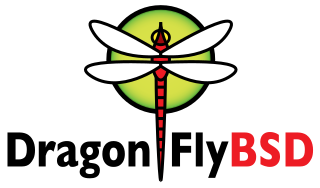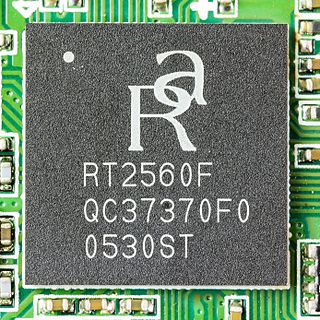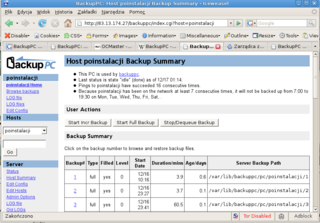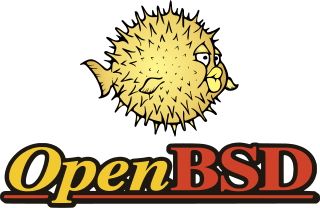
DragonFly BSD is a free and open-source Unix-like operating system forked from FreeBSD 4.8. Matthew Dillon, an Amiga developer in the late 1980s and early 1990s and FreeBSD developer between 1994 and 2003, began working on DragonFly BSD in June 2003 and announced it on the FreeBSD mailing lists on 16 July 2003.
PF is a BSD licensed stateful packet filter, a central piece of software for firewalling. It is comparable to netfilter (iptables), ipfw, and ipfilter.

Matthew Dillon is an American software engineer known for Amiga software, contributions to FreeBSD and for starting and leading the DragonFly BSD project since 2003.
IPFilter is an open-source software package that provides firewall services and network address translation (NAT) for many Unix-like operating systems. The author and software maintainer is Darren Reed. IPFilter supports both IPv4 and IPv6 protocols, and is a stateful firewall.
The Common Address Redundancy Protocol or CARP is a computer networking protocol which allows multiple hosts on the same local area network to share a set of IP addresses. Its primary purpose is to provide failover redundancy, especially when used with firewalls and routers. In some configurations, CARP can also provide load balancing functionality. CARP provides functionality similar to VRRP and to Cisco Systems' HSRP. It is implemented in several BSD-based operating systems and has been ported to Linux (ucarp).

Russell "Russ" Nelson is an American computer programmer. He was a founding board member of the Open Source Initiative and briefly served as its president in 2005.

Ralink Technology, Corp. was a Wi-Fi chipset manufacturer mainly known for their IEEE 802.11 chipsets. Ralink was founded in 2001 in Cupertino, California, then moved its headquarters to Hsinchu, Taiwan.
sysctl is a software utility of some Unix-like operating systems that reads and modifies the attributes of the system kernel such as its version number, maximum limits, and security settings. It is available both as a system call for compiled programs, and an administrator command for interactive use and scripting. Linux additionally exposes sysctl as a virtual file system.
In computing, ioctl is a system call for device-specific input/output operations and other operations which cannot be expressed by regular system calls. It takes a parameter specifying a request code; the effect of a call depends completely on the request code. Request codes are often device-specific. For instance, a CD-ROM device driver which can instruct a physical device to eject a disc would provide an ioctl request code to do so. Device-independent request codes are sometimes used to give userspace access to kernel functions which are only used by core system software or still under development.

ipfirewall or ipfw is a FreeBSD IP, stateful firewall, packet filter and traffic accounting facility. Its ruleset logic is similar to many other packet filters except IPFilter. ipfw is authored and maintained by FreeBSD volunteer staff members. Its syntax enables use of sophisticated filtering capabilities and thus enables users to satisfy advanced requirements. It can either be used as a loadable kernel module or incorporated into the kernel; use as a loadable kernel module where possible is highly recommended. ipfw was the built-in firewall of Mac OS X until Mac OS X 10.7 Lion in 2011 when it was replaced with the OpenBSD project's PF. Like FreeBSD, ipfw is open source. It is used in many FreeBSD-based firewall products, including m0n0wall and FreeNAS. A port of an early version of ipfw was used since Linux 1.1 as the first implementation of firewall available for Linux, until it was replaced by ipchains. A modern port of ipfw and the dummynet traffic shaper is available for Linux and Microsoft Windows. wipfw is a Windows port of an old (2001) version of ipfw.

BackupPC is a free disk-to-disk backup software suite with a web-based frontend. The cross-platform server will run on any Linux, Solaris, or UNIX-based server. No client is necessary, as the server is itself a client for several protocols that are handled by other services native to the client OS. In 2007, BackupPC was mentioned as one of the three most well known open-source backup software, even though it is one of the tools that are "so amazing, but unfortunately, if no one ever talks about them, many folks never hear of them".
There are a number of Unix-like operating systems based on or descended from the Berkeley Software Distribution (BSD) series of Unix variant options. The three most notable descendants in current use are FreeBSD, OpenBSD, and NetBSD, which are all derived from 386BSD and 4.4BSD-Lite, by various routes. Both NetBSD and FreeBSD started life in 1993, initially derived from 386BSD, but in 1994 migrating to a 4.4BSD-Lite code base. OpenBSD was forked from NetBSD in 1995. Other notable derivatives include DragonFly BSD, which was forked from FreeBSD 4.8, and Apple Inc.'s iOS and macOS, with its Darwin base including a large amount of code derived from FreeBSD.

FreeBSD is a free and open-source Unix-like operating system descended from the Berkeley Software Distribution (BSD), which was based on Research Unix. The first version of FreeBSD was released in 1993. In 2005, FreeBSD was the most popular open-source BSD operating system, accounting for more than three-quarters of all installed simply, permissively licensed BSD systems.
Xenocara is the OpenBSD build infrastructure for the project's customised X.Org Server that utilises a dedicated _x11 user by default to drop privileges and perform privilege separation in accordance to OpenBSD's "least privilege" policy.

OpenBSD is a security-focused, free and open-source, Unix-like operating system based on the Berkeley Software Distribution (BSD). Theo de Raadt created OpenBSD in 1995 by forking NetBSD. According to the website, the OpenBSD project emphasizes "portability, standardization, correctness, proactive security and integrated cryptography."
Write Ahead Physical Block Logging (WAPBL) provides meta data journaling for file systems in conjunction with Fast File System (FFS) to accomplish rapid filesystem consistency after an unclean shutdown of the filesystem and better general use performance over regular FFS. With the journal, fsck is no longer required at system boot; instead, the system can replay the journal in order to correct any inconsistencies in the filesystem if the system has been shutdown in an unclean fashion.

The OpenBSD Journal is an online newspaper dedicated to coverage of OpenBSD software and related events. The OpenBSD Journal is widely recognized as a reliable source of OpenBSD-related information. It is a primary reporter for such events as Hackathons. The site also hosts the OpenBSD developers' blogs.
The sysctl hw.sensors framework is a kernel-level hardware sensors framework originating from OpenBSD, which uses the sysctl kernel interface as the transport layer between the kernel and the userland. As of 2019, the framework is used by over a hundred device drivers in OpenBSD to export various environmental sensors, with temperature sensors being the most common type. Consumption and monitoring of sensors is done in the userland with the help of sysctl, systat, sensorsd, ntpd, snmpd, ports/sysutils/symon and GKrellM.
The bio(4) pseudo-device driver and the bioctl(8) utility implement a generic RAID volume management interface in OpenBSD and NetBSD. The idea behind this software is similar to ifconfig, where a single utility from the operating system can be used to control any RAID controller using a generic interface, instead of having to rely on many proprietary and custom RAID management utilities specific for each given hardware RAID manufacturer. Features include monitoring of the health status of the arrays, controlling identification through blinking the LEDs and managing of sound alarms, and specifying hot spare disks. Additionally, the softraid configuration in OpenBSD is delegated to bioctl as well; whereas the initial creation of volumes and configuration of hardware RAID is left to card BIOS as non-essential after the operating system has already been booted. Interfacing between the kernel and userland is performed through the ioctl system call through the /dev/bio pseudo-device.
A virtual kernel architecture (vkernel) is an operating system virtualisation paradigm where kernel code can be compiled to run in the user space, for example, to ease debugging of various kernel-level components, in addition to general-purpose virtualisation and compartmentalisation of system resources. It is used by DragonFly BSD in its vkernel implementation since DragonFly 1.7, having been first revealed in September 2006, and first released in the stable branch with DragonFly 1.8 in January 2007. The long-term goal, in addition to easing kernel development, is to make it easier to support internet-connected computer clusters without compromising local security. Similar concepts exist in other operating systems as well; in Linux, a similar virtualisation concept is known as user-mode Linux; whereas in NetBSD since the summer of 2007, it has been the initial focus of the rump kernel infrastructure.








